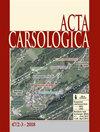The microbial community structure of the Dupnisa cave in Kırklareli, Turkey
IF 1.1
4区 地球科学
Q4 GEOSCIENCES, MULTIDISCIPLINARY
引用次数: 3
Abstract
Cave ecosystems count to be extreme environments due to their stable temperature, darkness, high humidity rates, and limited organic materials. In this context, these ecosystems represent invaluable laboratories for microbiological studies. Although there are common features between the microorganism groups obtained from the culture-based microbiological studies conducted in the caves and the groups highlighted through molecular methods, the microorganism groups determined through this last method are richer. The detected microorganisms are variable depending on the characteristics of each cave. The aim of this study is to determine the microbial diversity in samples taken from 5 different regions (including regions visited by tourists) of Dupnisa Cave and to reveal the differences between these regions. This is the first microbiological study running in cave sediments of Dupnisa Cave System situated in the north-western of Turkey. In this study, using the Illumina MiSeq next-generation sequencing approach for analyses of Dupnisa Cave samples, 14 phyla and 298 genera as well as 2 phyla and 20 genera can be attributed to bacterial and archaea OTUs, respectively. Moreover, the bacterial community is dominated by the phyla Proteobacteria, Actinobacteria, Bacteroidetes, Gemmatimonadetes, Firmicutes, Nitrospirae, Chloroflexi and Acidobacteria distributed with 1 % and above. Archaeal community is represented by Thaumarchaeota and Euryarchaeota phyla. Proteobacteria is the most dominant bacterial phylum and Thaumarchaeota dominates the archaeal phyla. The highest number of types of bacteria according to Chao 1 richness estimation index were found at point AF (cave entrance / sediment), and that of types of archaea were found at point F2 (touristic area 2 / cave sediment). F2 was determined as the sampling point with the highest diversity of archaeal and bacterial genera according to Shannon-Wiener diversity index.土耳其Kırklareli的Dupnisa洞穴的微生物群落结构
洞穴生态系统由于其稳定的温度、黑暗、高湿度和有限的有机物质而被视为极端环境。在这种情况下,这些生态系统代表了微生物研究的宝贵实验室。尽管从洞穴中进行的基于培养的微生物研究中获得的微生物群与通过分子方法突出的微生物群之间存在共同特征,但通过最后一种方法确定的微生物群更丰富。根据每个洞穴的特征,检测到的微生物是可变的。本研究的目的是确定从杜普尼萨洞穴的5个不同地区(包括游客到访的地区)采集的样本中的微生物多样性,并揭示这些地区之间的差异。这是首次在土耳其西北部Dupnisa洞穴系统的洞穴沉积物中进行微生物学研究。在本研究中,使用Illumina MiSeq下一代测序方法分析Dupnisa洞穴样本,可以分别将14个门和298个属以及2个门和20个属归属于细菌和古菌OTU。此外,细菌群落以变形菌门、放线菌门、拟杆菌门、双球菌门、厚壁菌门、硝化螺旋菌门、氯弯菌门和酸杆菌门为主,分布在1%及以上。古生物群落以Thaumarchaeota和Euryarchaeota门为代表。变形菌门是最具优势的细菌门,Thaumarchaeota在古菌门中占主导地位。根据Chao 1丰富度估计指数,细菌类型最多的是AF点(洞穴入口/沉积物),而古菌类型最多的则是F2点(旅游区2/洞穴沉积物)。根据Shannon Wiener多样性指数,F2被确定为古菌属和细菌属多样性最高的采样点。
本文章由计算机程序翻译,如有差异,请以英文原文为准。
求助全文
约1分钟内获得全文
求助全文
来源期刊

Acta Carsologica
地学-地球科学综合
CiteScore
1.50
自引率
14.30%
发文量
0
审稿时长
>12 weeks
期刊介绍:
Karst areas occupy 10-20 % of ice-free land. Dissolution of rock by natural waters has given rise to specific landscape and underground. Karst surface features and caves have attracted man''s curiosity since the dawn of humanity and have been a focus to scientific studies since more than half of millennia.
Acta Carsologica publishes original research papers and reviews, letters, essays and reports covering topics related to specific of karst areas. These comprise, but are not limited to karst geology, hydrology, and geomorphology, speleology, hydrogeology, biospeleology and history of karst science.
 求助内容:
求助内容: 应助结果提醒方式:
应助结果提醒方式:


